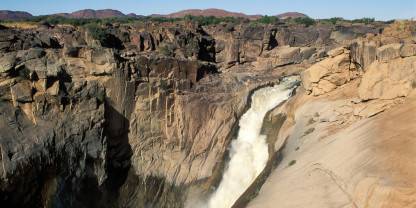Average Expert Rating
Rating Breakdown
Write a User ReviewRock Dassie delight
If you’ve never seen a rock dassie sprawled out on a boulder in full sunshine squinting lazily as you approach, then make your way here immediately. It’s sooooooooo cute! In a deep rocky ravine, with stunning scenery, this park is named after the world’s sixth longest waterfall and is an impressive sight after a wetting in rainy season.
The 10km Dassie Trail, involves scrambling over rocks and oohhhing and aaahhhing every time one of the little furballs is in sight. Apparently they are related to elephants although I have no idea how this is possible as it’s like saying a hippo is related to a dung beetle. You’ll most likely spot some antelope too, especially the klipspringer which loves bounding around this rocky landscape.
Birds or Bats?
The clue to this park is in its name as the main focus here is the magnificent 56-metre waterfall and the gorge carved out by the Orange River. In full flood it’s a tremendous, thundering experience and in the dry season you can peer right down into the abyss to the river below. Despite the beautiful rocky landscapes, the park doesn’t appear on many peoples’ game viewing itineraries. There are springbok, gemsbok, giraffe and mountain zebra here with predators including jackal, caracal, bat-eared fox and African wild cat but the latter are largely nocturnal.
My favourite memory here was having sundowners on the rocks by the waterfall and watching literally clouds of feeding swifts and swallows in and above the gorge. But a few minutes later we looked up and we saw they were bats, not birds! How could we have got it so wrong? The next evening we watched more carefully and saw the imperceptible change from bird to bat as one completely different animal took over from the other in the space of no more than five minutes.
A rocky desert environment with a raging waterfall spilling into a granite gorge
The primary reason for visiting this park is to admire the impressive waterfall. The Orange River passes over a series of cataracts before dropping 56 metres into a narrow gorge of steep, smooth rock; the water churning below. On our visit, which followed heavy rains, we also saw a number of smaller waterfalls along the sides of the main falls; a sight which I understand is quite rare. The surrounding landscape of moulded granite formations appeared barren, but it was rich in wild plants, and I enjoyed watching a number of comical ground squirrels foraging between the rocks. Other wildlife in the park includes klipspringer, eland, kudu, gemsbok and springbok, but these all tend to be fairly elusive. You only need an hour or so to see the falls themselves, so a visit can be worked into a longer itinerary – in our case en route to the Kgalagadi Transfrontier Park.
Big Skies and an Impressive Waterfall
The name Augrabies actually comes from a corruption of the Khoi-San word meaning ‘Place of Great Noise’: an apt description for the deafening roar produced by the water as it thunders down the 56m high Augrabies Waterfall, especially when the Orange River is in full flood. Wildlife is sparsely distributed in this arid realm with klipspringer, springbok, gemsbok and giraffe being the most commonly viewed species. Although there are a couple of black rhinos resident here, most safari-goers coming to Augrabies with a desire to see Africa’s big charismatic wildlife would end up leaving disappointed. For me, the overnight Klipspringer Hiking Trail is the park’s premier attraction; this self-guided multi-day walk allows visitors to escape the car and really appreciate the park’s picturesque geological attractions like Moon Rock, Ararat and Echo Corner, not to mention the 18km Orange River Gorge carving its way through the centre of this arid park.

